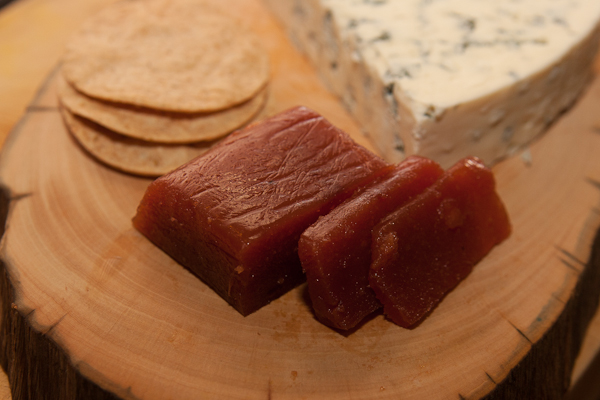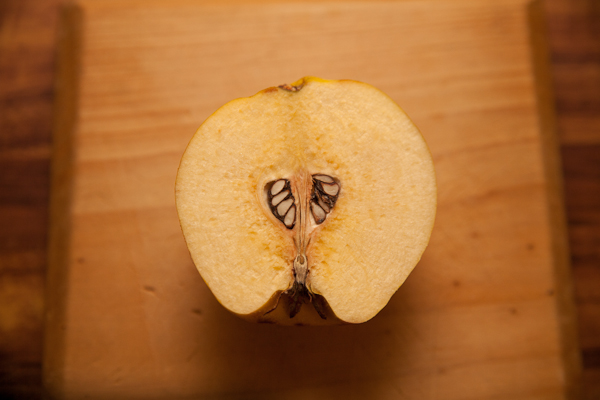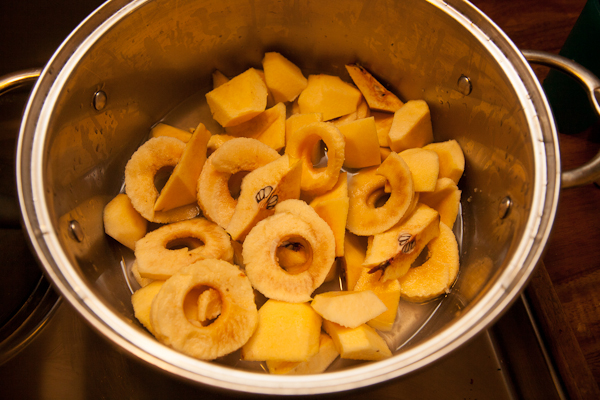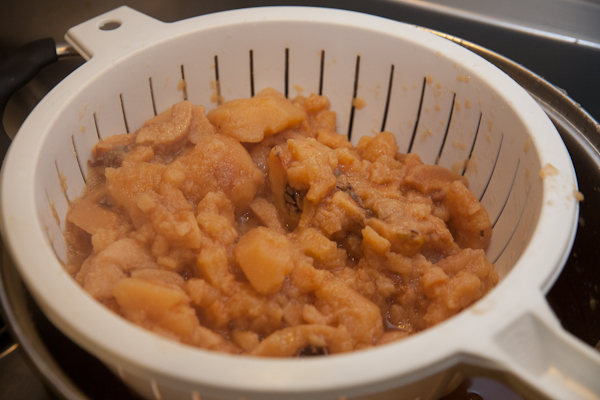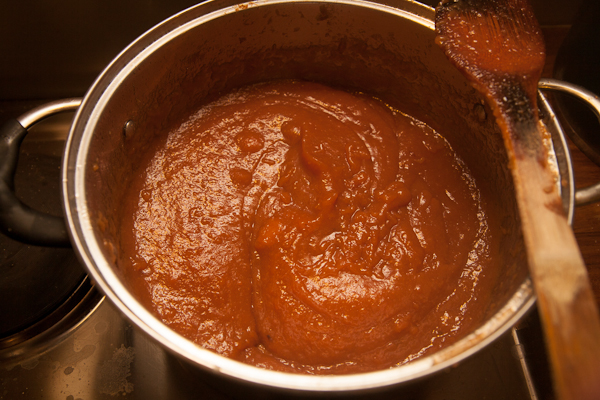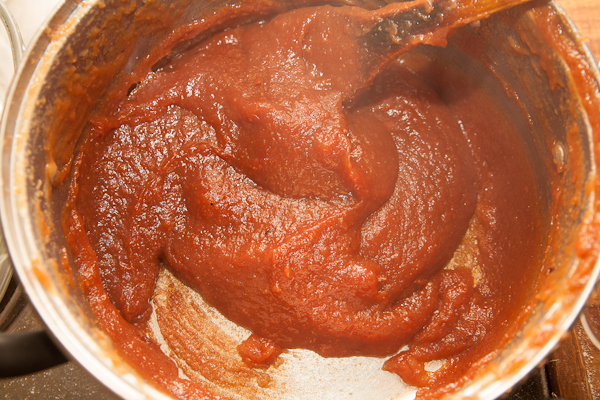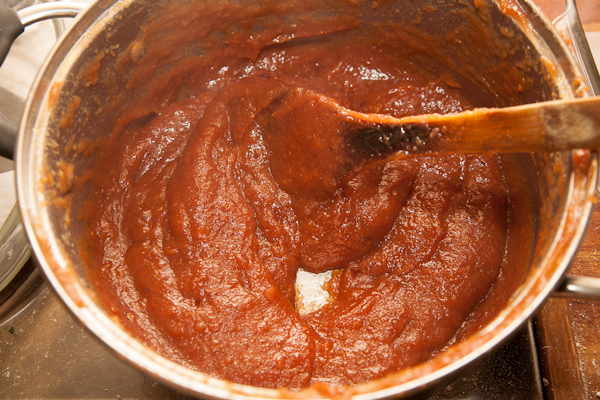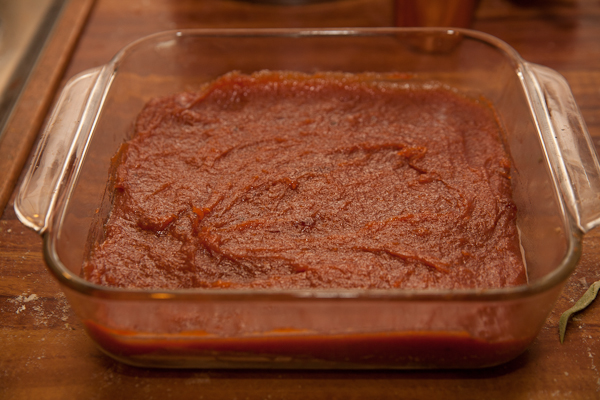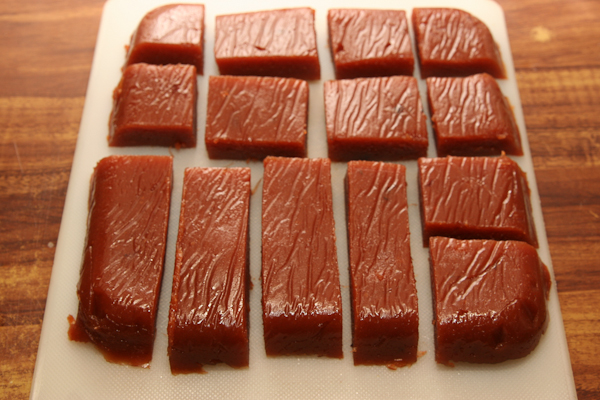With their rich perfume and deep red colour when cooked, quinces are one of my favourite fruit. They are fantastic simply stewed and served with thick cream, or in a crumble or pie, but the bulk of the roadside quinces we pick every autumn go to making quince paste. Quince paste (Membrillo in Spain or Cotagnata in Italy) is a ruby red slab of stewed, pureed and dried out quinces that is absolute heaven paired with any cheese with attitude – like parmesan, gorgonzola or goat cheese. It costs an arm and a leg for just a little chunk in the shops so the few hours spent simmering and stirring pay off quickly.
Quince paste sets primarily because of its high pectin content. Pectin forms a gel when cooked with sugar and acid (lemon juice here) and if you get it just right, the paste will set as soon as it cools. If it doesn’t set quite right, simply drying out the paste helps it become stiff enough to slice. Drying can be accomplished by leaving the paste in the oven on the lowest setting overnight, door open a crack, or leaving it anywhere warm like a car until dry enough.
Ingredients
- 8-10 medium quinces, peeled and cored. The apple peeler I described here works surprisingly well. Just a note – in On Food and Cooking, Harold McGee says the skin can be left on for more aroma. I haven’t tried this yet so proceed with caution as quince skin can be furry. I’d scrub it well at least.
- Raw or white granulated sugar
- Juice of 1.5 lemons
Method
Roughly dice the peeled and cored quinces. Add to a large saucepan with 2 cups water. Adding half the cores can help the paste set even better, but you have to either pick them out or ignore the odd grainy bit in the finished paste (not objectionable). Bring to the boil and simmer for 30 minutes.
This next step is a little fiddly but it helps get the sugar quantity just right so the pectin sets properly. Tip the cooked fruit into a colander set over a bowl to catch the juices. Weight the fruit alone and then weigh 3/4 of that weight in sugar. Add sugar, fruit and juices back to the saucepan. If you can’t be bothered with all that measuring, just add 4 cups of sugar and hope for the best.
Here’s where you need to get comfy – the mixture needs to be simmered over low-medium heat for 2-3 hours, stirred every few minutes. I settle in with a book in one hand and a spatula in the other. Scrape the bottom as you stir, and consider wearing a glove or mitt as the mixture can spit globs of molten fruit and sugar.
The lumps of fruit need to be pureed till they are smooth at some point but if you leave it as long as possible, the mixture doesn’t spit and stick quite so much. I remove any obvious cores and then puree after about an hour of simmering, with a stick blender, food processor or food mill.
The goal here is to reduce the mixture to a thick paste and get that lovely deep red colour. The colour comes with time more than anything, so if the paste is looking very thick but not yet the colour you want, add half a cup of water at a time and keep cooking. When the paste is quite thick and starting to stick together when stirred, add the lemon juice and keep cooking.
It’s ready when the mixture can stand up in peaks when stirred, and it might be pulling away from the sides of the pan when stirred. You can flick a drop onto a plate and see if it solidifies a little as it sets.
Line a baking tray with baking paper with a drop of oil rubbed over it and pour the mixture in. Use the back of a wet spoon to smooth down the top, cover and set aside to dry. A smaller pan will yield a thicker slab of paste obviously.
When completely cool, prod to see if it is solid enough to turn out. If not, dry as above. When solid enough, turn out onto a chopping board and cut into slabs. I cut different sizes for different occasions – little ones for a cheeky nibble and big ones for entertaining guests. The pieces keep best wrapped tightly in cling wrap, then bagged. They last for a long time – after 9-12 months you might find some of the sugar starting to go crunchy round the outside, but this doesn’t affect the flavour.
Heaven!
Variations
I sometimes add a star of star anise, or a stick of cinnamon for another layer of flavour. Recipes for Membrillo, the Spanish version, often add 1 scraped vanilla pod. Recipes for Cotagnata, THe Italian version, sometimes call for a few bay leaves.
More Reading
Simply Quince – history, traditions & recipes
Cotagnata – Sicilian Quince Paste
How to make Membrillo – you’ll see that all the recipes are very much similar.
